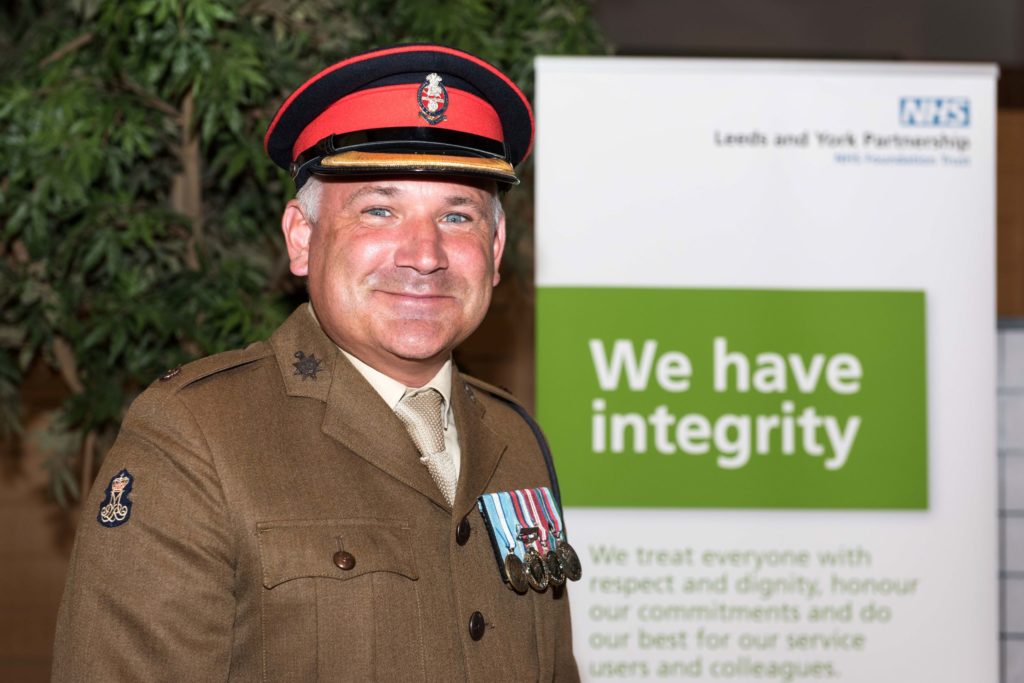Leadership blog - August 2021
As the organisation continues to reset and recover, our Chief Executive Dr Sara Munro has resumed her monthly leadership blogs. In this first one since January 2020, Sara talks about refreshing our strategic objectives following 18 months of pandemic incident response.
We’ve recently enjoyed a few significant events that mark our reset and recovery journey, and hopefully a transition to some kind of normality following a year and a half of hell.
Firstly on Monday 26 July I was joined by our Chair Professor Sue Proctor in welcoming the Lord Lieutenant of West Yorkshire Ed Anderson, in person, at a special event at the Royal Armouries Museum in Leeds. We were part of a small socially-distanced group which included LYPFT armed forces veterans and active reservists, where we received the Veteran Aware Accreditation for our commitment to improving the health and lives of armed forces veterans and reservists.
A special mention must go to Major Dan Brooks (pictured below), an Army Reserve Officer in the Fourth Battalion of the Princess of Wales’ Royal Regiment, and the Implementation Manager for our Veterans’ Mental Health High Intensity Service. Dan is the driving force behind the Veteran Aware accreditation work and we salute him for his commitment and passion. Read more about it on our website.
Secondly, on 29 July, we held our first Trust Board meeting in person since January 2020. It was great to see colleagues and guests in the flesh again, albeit in a highly covid safe way. If you’re interested in what we talked about, you can read the full Trust Board papers on our website.
The Trust Board has dedicated a lot of time over the last few months to renewing our Trust’s strategic objectives. It is important we’re able to articulate what is important to us, and what we all need to be concentrating on to fulfil our ambitions.
The way that health and care is managed above us is changing. Proposed changes in legislation for the NHS, which are currently working their way through Parliament, will take effect from 1 April 2022.
Integrated Care Systems will become statutory organisations and Clinical Commissioning Groups will no longer exist. Our main Integrated Care System is West Yorkshire and Harrogate, who have posted this useful update on their website for those interested in the detail.
As a Board we’ve talked a lot recently about how this affects us, what our role is both in West Yorkshire and Harrogate, and the Humber, Coast and Vale area. It’s clear that system partnership working is now the norm, with service development and improvement taking place at scale across multiple agencies. A good example being the recently-launched Community Rehabilitation Enhanced Support Team (or CREST) – the first phase of which went live across Kirklees, Calderdale and Leeds in April.
Our key challenges
As a Board we’ve identified a number of key challenges. Some of which have always been there, some are new, and some have been exacerbated by the pandemic.
Here’s the headlines:
- An increased demand for our core mental health and learning disability services, coupled with changing models of service delivery,
- The impact of health inequalities in our local communities which impacts on demand regarding access and outcomes for our service users and carers,
- Staff shortages which have been long-standing in mental health and learning disability services,
- Our use of estate has changed significantly for out-of-hospital provision, and we need to adapt our working environments to enable our workforce to have the right tools for the job,
- Investing in our inpatient estate to make it the best environment for future care needs. Our inpatient estate is provided within a Private Finance Initiative (PFI) arrangement which ends in 2028, so we need to progress a replacement strategy. We want our new Red Kite View inpatient unit to set the standards for this, and
- We need to continue to build on our culture with our workforce so they are well supported, engaged, enabled to thrive and have fulfilling careers. In doing so we’ll continue to tackle and challenge the discrimination experienced by Black, Asian and minority ethnic colleagues in particular.
Strategic objectives – 2021 and beyond
We’ve identified our top three areas that we should focus on for the next three years. The table below is a very high-level summary but hopefully enough to give you the headlines.
| Strategic objectives
|
Specific areas of focus |
| 1. Our Workforce | Develop a clear workforce strategy – including our commitment to be an inclusive organisation.
Recruiting new people and retaining them. Morale and wellbeing (including organisational culture and equality, diversity and inclusion). Key performance indicators – how we’ll know our strategy is working. |
| 2. Clinical Services – the reset and recovery of our future operating model for our clinical services | Capacity and flow of service users through the health and care system.
Embedding our approach to tackling health inequalities regarding access, experience and outcomes for service users and carers. Better use of digital technology in care delivery. Improving quality and outcomes. |
| 3. Estates and facilities – and our longer-term strategy for use of estates | Our strategy for replacing/upgrading our PFI estate.
Improving the configuration of sites where we provide clinical services. Improving our non-clinical sites. Opening and running Red Kite View – our new children and young people’s mental health inpatient unit. |
We see key enablers like quality, diversity & inclusion, digital and good financial governance cutting across these three strategic objectives.
Next steps
There is clearly a lot of detail behind all this and we’ve got a bit more work to do on it over the summer.
We’ll be having a ‘Board to Board’ session with our Council of Governors in September where I hope we’ll be in a position to sign off a final version of our refreshed strategic objectives. We’ll then be looking to embed this across our organisation, through our supporting committees and groups and also through our organisational culture too.
Read more about our Chief Executive Dr Sara Munro on our website.

